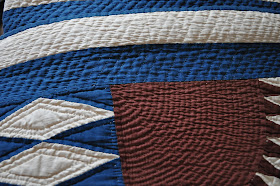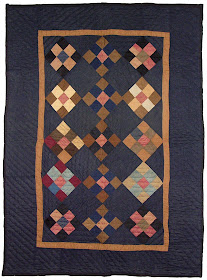 |
| Baby in Tub quilt, published in "Black Threads" by Kyra Hicks |
I feel like a toddler stepping into a washtub and really
feeling the warmth of the water for the first time.
The purchase of two quilts through eBay two weeks ago fueled my desire to learn more about African American quilts and quilt makers, and there's a lot to learn! I purchased
a quilt from Gee's Bend, Alabama, which, as it turns out, may hold some big surprises in terms of attribution. More about that another time.
I purchased a second quilt,
Baby in Tub, published in "
Black Threads: An African American Quilting Sourcebook" by noted scholar, author, and quilt maker
Kyra Hicks of Arlington, Virginia. Hicks was selling both quilts and two others from her personal collection, including a Smithsonian reproduction
Harriet Powers Bible Quilt.
As we know, Gee's Bend received a staggering amount of media attention and acclaim from the arbiters of connoisseurship the art world when the quilts were first brought to the attention of the art world in 2002. But it seems the non-objective aesthetic seen in the quilts of Gee's Bend is just the tip of the iceberg when it comes to African American quilts and quilt makers.
 |
| "The Wedding, The Lover's Trilogy: #1" by Faith Ringgold |
When I started poking around on the internet, I learned that the non-objective works may not even be the most representative of what a majority of artists are doing today. Pictorial, narrative, storytelling quilts seem to be more prevalent among artists. One of these artists is Faith Ringgold, whose work I first saw in New York nine years ago as part of the "Heritage of Genius" exhibition sponsored by the Durst Organization.
The exhibition, curated by L.L. Powers, Eleanor Bingham Miller and Shelly Zegart, was displayed in three locations, and Ringgold's quilt "The Wedding, The Lover's Trilogy: #1" was one of the contemporary works that stood out to me. It was visually engaging, and contained a potent narrative. At the time, I was just at the beginning of my journey as a quilt collector. Two of my antique quilts were part of the show, and admittedly, I knew nothing about contemporary quilt artists. Ringgold's work was almost too much for me to process at the time. It seemed like it was more of the realm of contemporary art than quilt making. Something I would've seen in a New York art gallery or museum of art rather than a quilt show.
Another artist whose work I have recently started to learn about is
Carolyn Mazloomi of West Chester, Ohio. Mazloomi, like Kyra Hicks, is a noted scholar and author. Her work also appears to be more part of the realm of narrative, storytelling quilts than the world of non-objective art. How fortunate I am to include Mazloomi, Hicks and a few other artists on my list of Facebook friends. I ask them lots of questions! During one of my Q & A sessions, there was a comment about how some folks have marginalized the work of African American quilt artists. That took me by surprise. Marginalizing this work is probably the last thing that would ever occur to me. I've loved everything I've seen.
The immediate result of all this learning, for me, is a rapidly growing book list. I've had the Gee's Bend catalog for years, and recently received Black Threads and ordered the "Freedom Quilting Bee: Folk Art and the Civil Rights Movement" by Nancy Callahan, and "Threads of Faith: Recent Works from the Women of Color Quilters Network" by Mazloomi. But I'm really just getting my feet wet. If you're reading this blog and have more book suggestions for me, please send me a comment.




















































